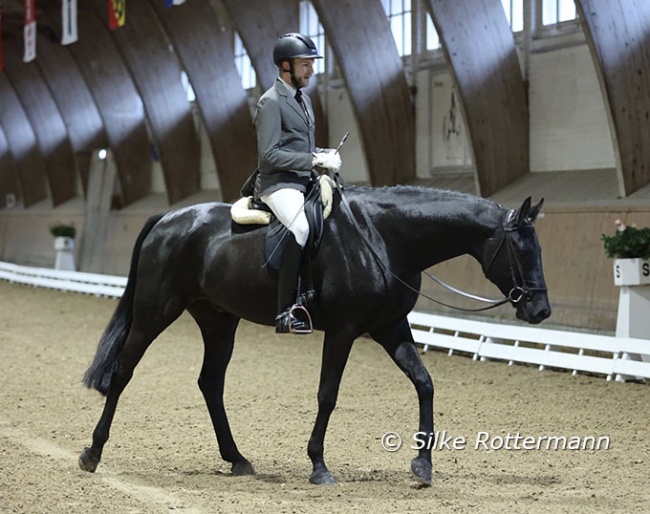
- By Max Jaquerod and Silke Rottermann
This article is a continuation of Fanti's Progress - What Good Dressage Training Can Do to a Horse and Part II: "The Rider Must Control Himself Before He Can Control His Horse"
In May 2023 Max Jaquerod, a Swiss amateur dressage rider, acquired a 6-year-old Swiss bred warmblood gelding Fantastico (by Frascino) from the Swiss Army where the horse had spent the previous two years in their versatile training program.
An avid advocate of classical dressage principles, the 28-year-old medical doctor took his new equine partner back to the basics in order to build a solid foundation for the black gelding’s future dressage career. Since the beginning of this new partnership Eurodressage has been following the new combination's journey, documenting problems and progress.
After a very brief visit in early November 2023 to watch Fantastico’s first start at elementary level after a successful first season at novice, it has been 4 months I had not attended any training session of the now 7-year-old gelding.
How long four months can be and how much can happen (for the better) became apparent as soon as Max put Fantastico out of the stables at the end of February 2024. The once quite narrow gelding has visibly muscled up and looks a lot more horse than in the late summer of 2023.
Taking a step up while refining the basics
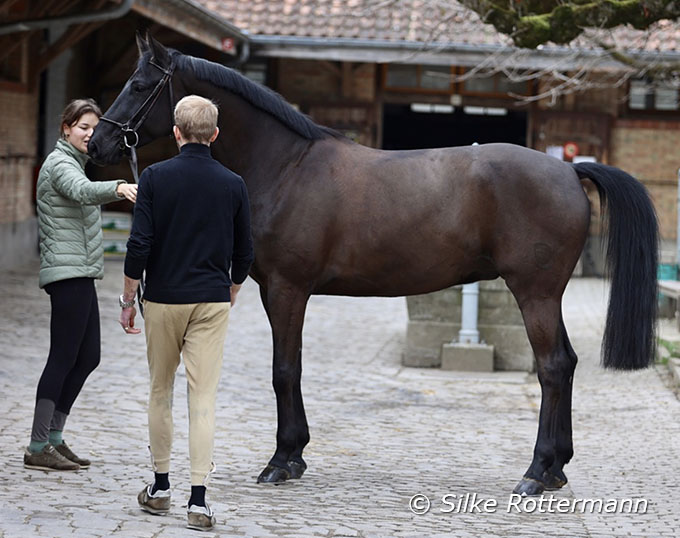
gelding has visibly filled out after 10 months of patient work
But to step the game up by asking movements which require a higher level of collection than I asked before does not mean this basic work is done and dusted. Straightening a horse and refining established aids is an ongoing process in our daily work. At this doorstep from basic work to more advanced one the horse is of course far from perfectly straightened and also not entirely submissive, so it is indispensable to continue working on elementary things in a horse’s training.
However, stepping up regarding collection gives the rider a valuable feedback of how well the basic training has been done because an increase of collection is only possible if the horse’s straightness and obedience to the aids have reached a certain level.
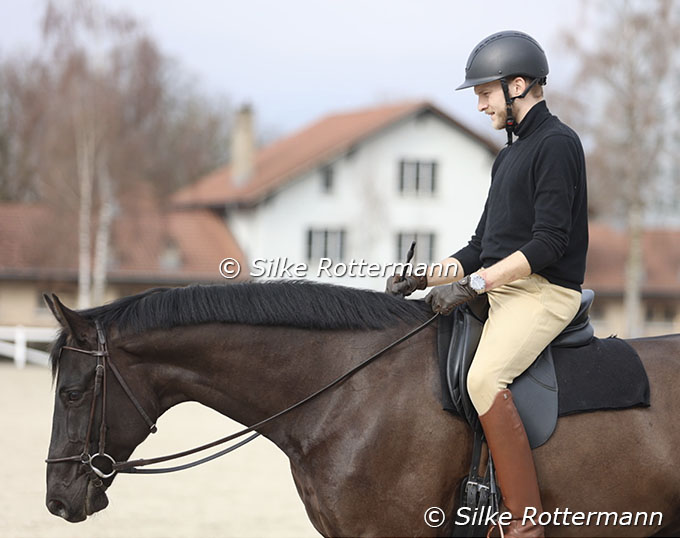
working phases and allow more breaks in between
We also have to be conscious about the fact that if we collect the gaits more, the young horse might first struggle with it as he is not used to it yet and has to find the degree of balance again which he had in the less collected movements before. For example if I collect the canter more than I did before and I ride on the centre line, Fantastico might start swaying slightly after some meters . Such mistakes are symptomatic at that stage of training and should not unsettle the rider because they indicate him what he still has to work on. Fanti’s swaying in canter off the track shows me he is still not enough at the outside aids and lacks straightness. So it is my task in the daily work to focus on and improve it. Until then I have to bear that these flaws are existing.

is an ongoing process, while stepping up the game
towards more collection
And I am always astonished that the „magic of classical equitation“ results in the desired effects if the training is correct. For example the horses begin to carry themselves more in collection if one pays strict attention to the straightness.
Exercises to increase the collection in canter
Even though our goal is to collect all basic gaits, I have a particular focus on Fanti’s canter as this is his least brillant gait.
To maintain the clear three-beat-rhythm I have mainly worked him in working tempo the first months and only after some time have started to slowly and slightly ask more collected strides for example by tightening a circle.
body due to an improved balance and carrying power
But the tightening of the circle can be used as the springboard for another exercise which challenges the young horse’s balance in a more collected frame. From the tightened circle I now change to the centre line or the track and ask a collected canter with a very pronounced couple of strides. It goes without saying that the horse has to be as straight as possible during this exercise and that less is more.
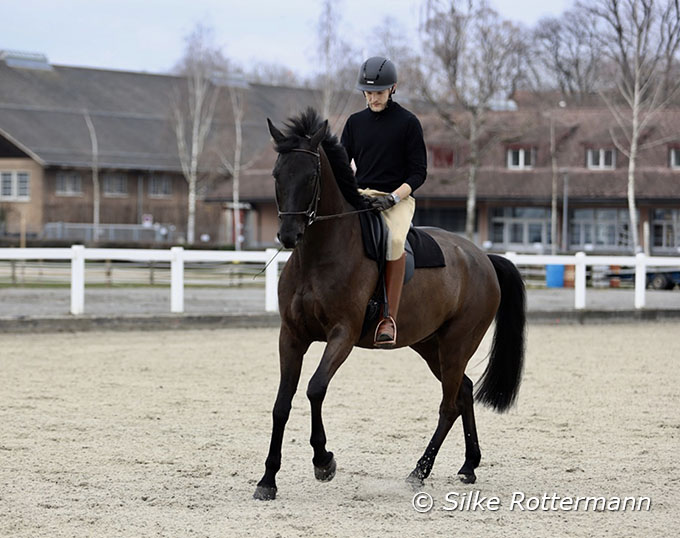
choice to improve Fanti’s naturally little uphill
canter
Fanti really taught me that a rider has to be very disciplined and strictly pay attention that the horse canters in a slight shoulder-fore which is paramount when straightening a horse in any gait. The straightness and therefore the canter improve which is a precondition for collection. And the horse also remains more straight in counter counter which in turn is an important precondition for well executed flying changes.
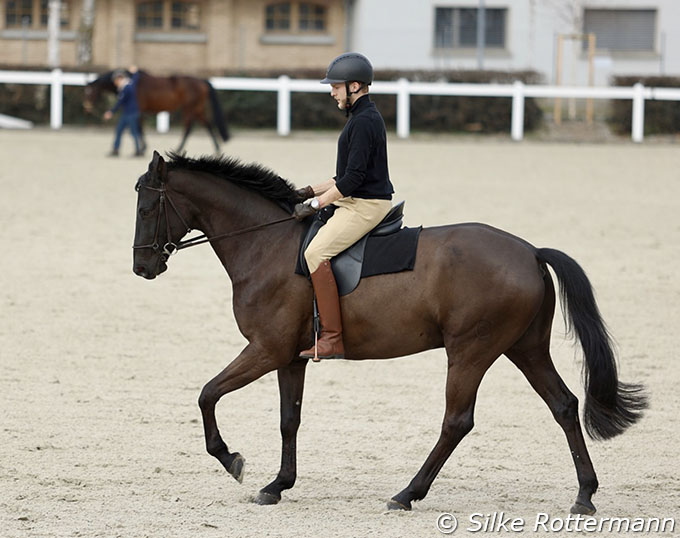
as easy as it sounds: One has to be very strict
to canter in an ever so slight shoulder-fore
position to improve the straightness
Some may interject that the horse might indeed shift at the beginning which actually can happen. But this is then only a small mistake which one can easily tolerate at the beginning, if the horse comes back and shows a nice transition. If it happens I can quickly say Fanti with my inside legs that he hasn’t to go to the inside. The horse understands this in no time.
Working on the throughness of the flying changes

helps improving the flying changes
as the counter canter improves the
balance in this gait
What has improved, but remains work in progress is his impatience to truly wait until I have prepared him the best to change. After teaching him the change I am not content anymore with him to execute the change, but the new goal is a nice change forward with an elevated stride. To achieve this a good preparation is indispensable. The more the training advances, the less time a horse requires to be in the new canter position.
But being such a diligent and willing horse and knowing exactly what is coming, Fanti often steals the change from me before I have prepared him well enough. This sometimes leads to changes with a high croup or an interrupted rhythm. But again, it only shows that the basic work needs to be continued while preparing for a higher level.
While it is absolutely wonderful to have a horse like Fanti who is so eager to please and who loves to get a cuddly reward after having done something well, it can also cause troubles of this kind.
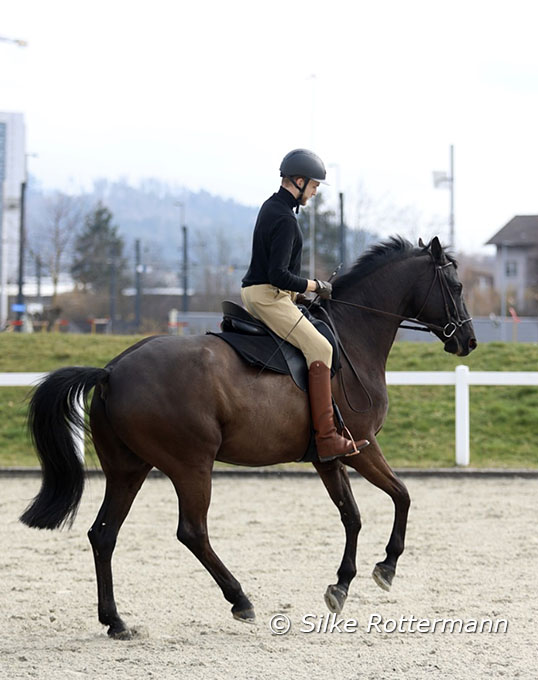
which flows forward from back to front
is to prepare the horse to be in the new
canter position from which the change
originates
My approach is now to not specifically focus on flying changes during a a part of our training session, so that neither Fanti nor I get psyched up for them. Instead I try to ride them every now and then during our training and I hope Fanti then gets used to them in a way he is not eagerly anticipating to change and get a praise for it.
What is also a beneficial exercise is the counter canter, also on bent lines which I have explained in the last article.
A Touchstone of Straightness and the Beginning of Collection
Most riders will be in unison that the rein-back is not the most favorite movement of their horses or themselves, although there are some horses who offer it quickly by themselves.
Not very spectacular to look it, it is nonetheless a true touchstone of the horse’s degree of throughness, a show-case of his achieved straightness and if well done, it is the beginning of collection.
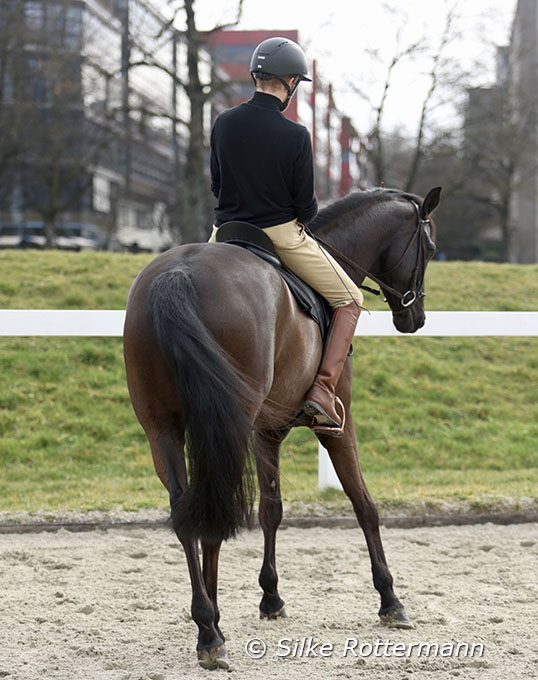
makes it easier for horses to learn
the rein-back without resistance
Like many other horses, Fanti is not very keen on walking backwards and this is probably caused by the fact that a prey animal like him would most likely not voluntarily execute this movement in nature at this length. As a result horses usually object against the rein-back when we first try to establish it and Fanti was no different, although he willingly goes backwards in hand.
If a horse objects the rein-back and we see that up to Grand Prix classes, it usually looks like if the defense to this movements originates from the mouth: The horse goes against the bit, hollows his back and puts the neck high (or curls in). The truth is that they do not object the rein-back in their mouth, but in their hindquarters and therefore it is there where we have to begin in our training.
The key while teaching rein-back is to be able to move the hind-legs in any direction the rider wants.
To make it easier and more pleasant for Fanti to develop to rein-back calm, straight and with slightly lowered hindquarters, I use an exercise he has learnt at the beginning of our partnership several months earlier: The turn on the forehand in which the horse has to move his hindquarters around his front. Fanti has already learnt through it that unilateral aids mean to move his croup and this helps tremendously to take away the horse’s defense in the rein-back.
As the turn is well established, I enlarge it until the horse does not turn anymore, but goes backwards. But here I have to go a bit more into details: During the usual execution of a turn on the forehand the pivot point is between both the horse’s front-legs. The hind-legs cross forward-sideways.
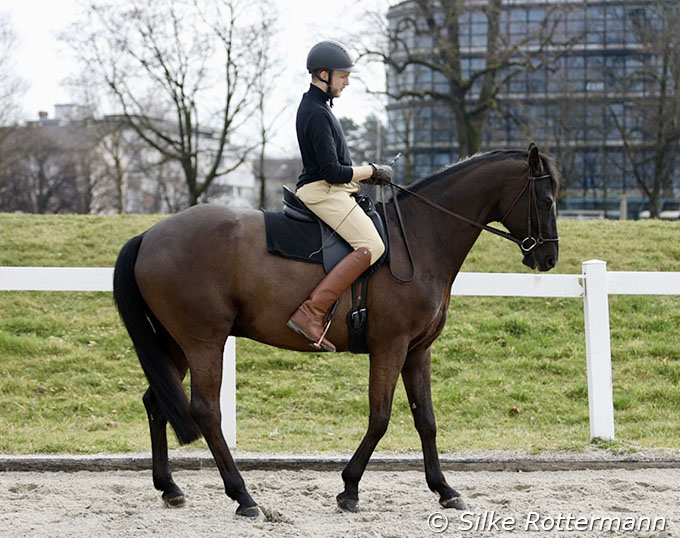
How does that all work in detail?
If I am on the left lead, I halt my horse and my right hand puts the horse to the right with the help of a slight lateral flexion. The right leg goes back, pushing the croup around. Now I mainly use my left rein to make sure the horse turns around his left front leg as a pivot point. If I can do that, he has to go with his right front leg “backwards” around the left one. The same thing happens with the hind legs. The whole turn occurs with a backwards-sideways tendency. This is the beginning of the rein-back. The horses understand this really quickly, thanks to the intuitiveness of the lateral aids when turning their shoulders. I then gradually “straighten” such a modified turn on the outside rein (in this example on the left) until it is no longer a turn. What remains is the impulse from moving the hindquarters with lateral aids. The one-sided nature of the aids also prevents the horse from associating it with pulling. I find this really an intuitive and great way to approach the difficulty of a rein-back and it is a typically classical exercise, as it goes from easy to difficult and its difficulty is solved with the help of another already established exercise. Ultimately I get the desired result in a completely unforced manner.
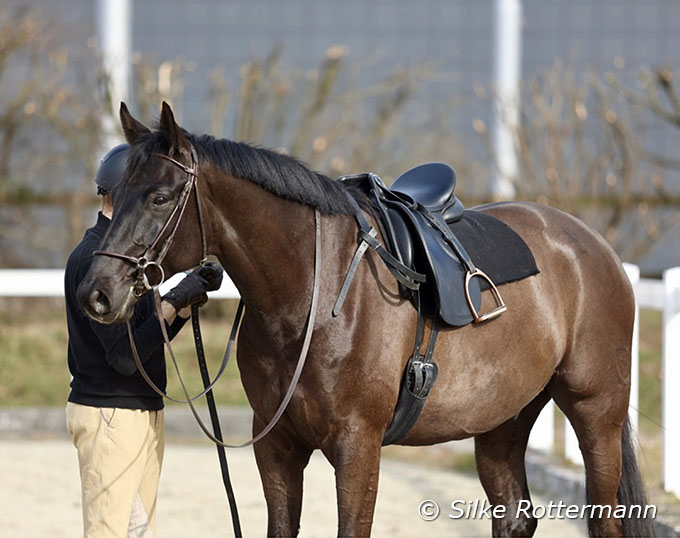
work in hand, Fantastico remains relaxed when
Max Jaquerod prepares him for this kind of work
The added advantage of teaching the rein-back after this method is that the horses are stepping back in clear rhythmic diagonals and not shuffling through the sand with delayed steps due to resistance.
If the horse has learnt the rein-back correctly, he not only remains straight and slightly chews the bit without changing his head-neck-position. It also takes weight on the hind-legs and bends in the joints so that the rein-back can also be considered the beginning of collection.
The First Diagonal Steps
As soon as Fanti had achieved the required straightness and degree of balance, we started making him acquainted with the first diagonal steps or „half steps“ which are the beginning of teaching a horse piaffe.

adjusting side-reins before the in-hand work
It is important to be aware that the piaffe is not an end in itself, but the result of collection which we aim in baby steps from the beginning of a horse’s training. And it is exactly these first beginnings of piaffe which are useful of collecting a younger horse.
What is of paramount importance is a calm atmosphere in which the horse is as relaxed and as straight as possible.
Many horses get very excited at the beginning of this work which is normal. It should be solved by a calm atmosphere and short exercising.
This relaxation was a challenge with Fanti at the beginning for a different reason. As I bought him as a basically trained horse at the age of 6, I have no idea which experiences he had previously made with in-hand work. But at the beginning he was quite afraid of the whip (which he perfectly accepts when being ridden) and clearly expected something unpleasant.
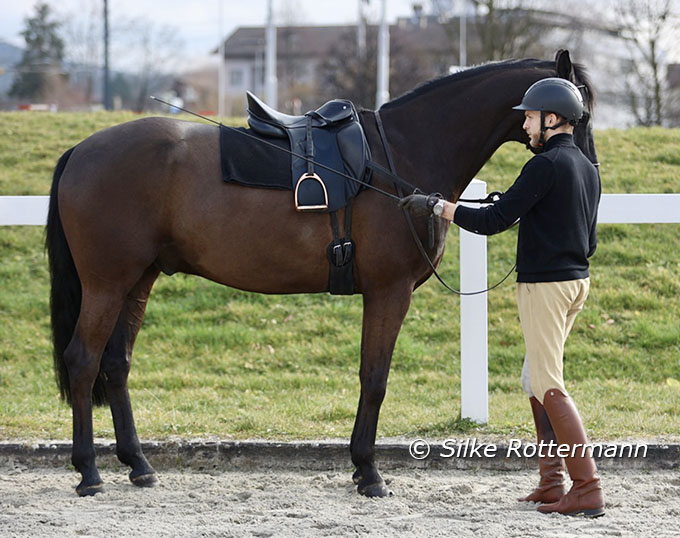
happen in a calm atmosphere and with a relaxed
and straight horse
Although this work paid dividends and Fanti now is much calmer and trusting us, he is not yet as relaxed as I would like him to be.
It is an art in itself to touch a horse : where, at which moment and with which intensity, but over all it is intuition and experience as each horse reacts differently. At my age I have not yet a great experience, but my grandfather has it in abundance and guided my horse and me at the beginning and still does twice a week.
As soon as Fanti showed a relaxed short walk in hand, I touched him on his musculature on the croup exactly the moment before he wanted to lift a hind-leg. His first reaction was to go away from the touching aid, but I managed to keep him in place by refined half halts until he showed a few diagonal steps. I immediately halted, praised and stroked him because this is the key moment when the horse has understood that it should diagonalize. Once the horse has understood this, one can start working on the half steps. On that day I repeated all twice more and Fanti showed me he had understood the procedure by offering 2-3 steps each time.
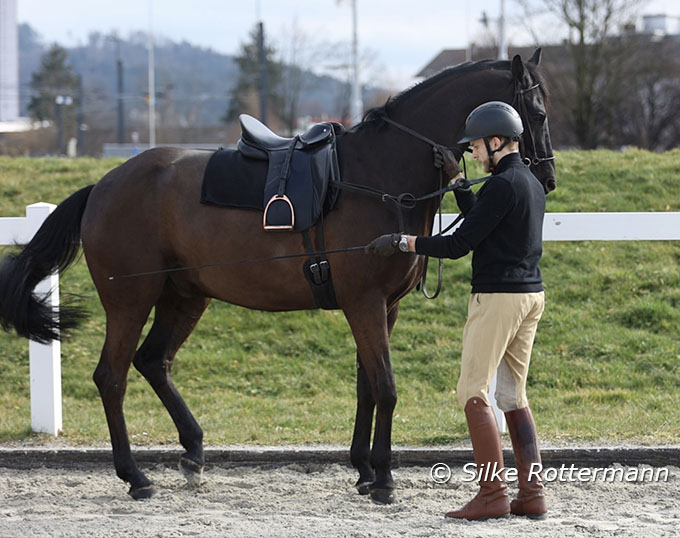
to diagonalize in hand. At this very beginning Fanti
showed more activity behind than in front and did not
remain absolutely straight
I usually repeat this exercise after riding for a few minutes because for Fanti to remain calm, regular repetitions in a quiet atmosphere are very beneficial. To keep a horse absolutely straight during the work in hand becomes a real challenge as soon as the horse gets excited and wants to begin.
Fanti is the type of horse that loves to work with human beings and tries his hardest to please, so now that he knows the exercises he gets quite impatient at times and does not wait for me to give indications. For that reason, after I started without I now use long standing side-reins to give him a kind of ‚guardrail‘. However, it is absolutely essential that they are long enough to not press the horse in a form. Because the desired frame in the piaffe is entirely the result of correct work and will come by itself with time.
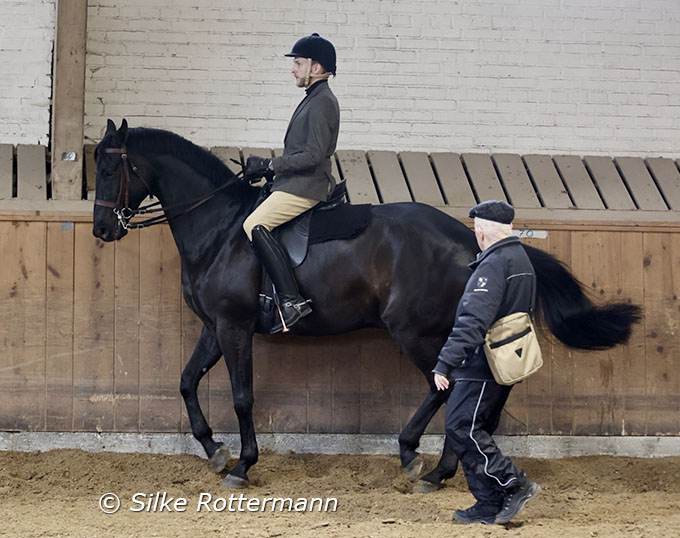
the concept of diagonalisation which is easier to
achieve with the rider in the saddle and experienced
help from the ground
Even during this beginnings of piaffe we can never make concessions regarding the straightness and the contact. Being excited or tense, horses tend to lean or even push down on the bit and no way we can allow this as the horse should become light in front. If Fanti begins to get pushy, I stop and walk until he has regained sufficient calmness and only then I try again. It is a patience game on certain days, but it is worth it to be patient and very strict about straightness, calmness and a light connection because there can never be compromises in a horse’s training, like Major Frank once said.
Whenever possible we practice the half steps from the saddle with my grand-father on the ground. Although the horse now has to carry the rider on his back, it is easier to keep the horse in the desired conditions I described earlier. My grand-father with his more than 70 years of experience is an invaluable help who knows exactly when and where to support the horse and make oneself understood.
The Season Ahead
After Fanti surprised us all a bit by winning his first novice classes in the early months of our partnership in summer 2023, I dared to step up to elementary level in the very last show of the 2023 season in early November. Fanti did not put a foot wrong, but his rider lost his way…

for a dressage horse: Here Fanti trains in a larger
group of riders called Berne Dragoons
While this article is again about Fanti’s dressage training, we also continue to offer him a varied training because I am fully convinced he benefits from it in every way.
My girlfriend Ivana recently did a Working Equitation clinic with him which Fanti clearly enjoyed and she jumps him, while I regularly train him in a larger group of riders called the „Berne Dragoons“ where he remains as rideable as when being worked alone.
He also regularly hacks in larger groups and about bigger distances like up to 20 km.
For me dressage training means to have the horse as pleasant, rideable and safely on the rider’s aids as possible, no matter what the circumstances.
By Max Jaquerod with Silke Rottermann - Photos by Silke Rottermann.
Related Links
Fanti's Progress - What Good Dressage Training Can Do to a Horse
Fanti's Progress Part II: "The Rider Must Control Himself Before He Can Control His Horse"
More Training and Classical Dressage Articles on Eurodressage
Pierre-Eric Jaquerod: Dressage Now Needs to be a Spectacle Instead of a Presentation of Expert Knowledge
Pierre-Eric Jaquerod: "Swiss Dressage Has Not Woken Up in Time for Transition"
World Championships Berne 1966 Through The Eyes Of…
The History of the Shoulder-In
"Welcome to the Circus" - A New Series on Classical Dressage and the Circus